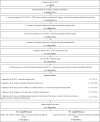Association Between Weight Gain and the Incidence of Cardiometabolic Conditions Among People Living with HIV-1 at High Risk of Weight Gain Initiated on Antiretroviral Therapy
- PMID: 35917003
- PMCID: PMC9618005
- DOI: 10.1007/s40121-022-00673-1
Association Between Weight Gain and the Incidence of Cardiometabolic Conditions Among People Living with HIV-1 at High Risk of Weight Gain Initiated on Antiretroviral Therapy
Abstract
Introduction: Antiretroviral therapy (ART) has been associated with weight gain in people living with HIV-1 (PLWH); however, limited research has assessed whether early weight gain post-ART initiation is associated with metabolic or cardiovascular outcomes among PLWH at high risk of weight gain (i.e., female, Black or Hispanic). This study aimed to evaluate the incidence of metabolic and cardiovascular outcomes between PLWH at high risk of weight gain following an observed ≥ 5% or < 5% weight/body mass index (BMI) gain within 6 months following ART initiation.
Methods: A retrospective longitudinal study using Symphony Health, an ICON plc Company, IDV® electronic medical records (October 1, 2014-March 31, 2021) identified adult female, Black, or Hispanic treatment-naïve PLWH who initiated ART and who had ≥ 1 weight or BMI measurement pre- and within 6 months post-treatment (landmark period). Inverse probability of treatment weighting was used to account for differences between PLWH who experienced ≥ 5% and < 5% weight/BMI gain. The time to each outcome was compared between cohorts using weighted hazard ratios (HRs) after the landmark period.
Results: Weighted ≥ 5% and < 5% cohorts included 620 and 632 patients, respectively; baseline characteristics were similar between the two cohorts (mean age: ~ 48 years, ~ 59% female, ~ 49% Black, ~ 17% Hispanic). During a mean 2-year follow-up, PLWH with ≥ 5% weight/BMI gain were significantly more likely to be diagnosed with type 2 diabetes mellitus (T2DM; HR = 2.19; p = 0.044). There were no significant differences in the incidence of any other outcomes between the study cohorts.
Conclusion: Despite a short 2-year follow-up, female, Black or Hispanic PLWH experiencing ≥ 5% weight/BMI increase within 6 months following ART initiation had an increased risk of T2DM, but not other metabolic or cardiovascular outcomes, likely due to the short follow-up period. Further research with longer follow-up and specific ART regimens is warranted to examine the impact of ART-related weight gain on long-term clinical outcomes.
Keywords: Antiretroviral therapy; Cardiovascular disease; HIV-1; Metabolic disease; Observational study; Weight gain.
© 2022. The Author(s).
Figures



Similar articles
-
Weight and BMI Changes Following Initiation of Emtricitabine/Tenofovir Alafenamide Co-Formulated with Darunavir or Co-Administered with Dolutegravir in Overweight or Obese, ART-Naïve People Living with HIV-1.Clinicoecon Outcomes Res. 2023 Jul 24;15:579-591. doi: 10.2147/CEOR.S413800. eCollection 2023. Clinicoecon Outcomes Res. 2023. PMID: 37521004 Free PMC article.
-
Incidence of cardiometabolic outcomes among people living with HIV-1 initiated on integrase strand transfer inhibitor versus non-integrase strand transfer inhibitor antiretroviral therapies: a retrospective analysis of insurance claims in the United States.J Int AIDS Soc. 2023 Jun;26(6):e26123. doi: 10.1002/jia2.26123. J Int AIDS Soc. 2023. PMID: 37306118 Free PMC article.
-
Body mass index increase and weight gain among people living with HIV-1 initiated on single-tablet darunavir/cobicistat/emtricitabine/tenofovir alafenamide or bictegravir/emtricitabine/tenofovir alafenamide in the United States.Curr Med Res Opin. 2022 Feb;38(2):287-298. doi: 10.1080/03007995.2021.2007006. Epub 2021 Dec 7. Curr Med Res Opin. 2022. PMID: 34812097
-
Antiretroviral therapy and weight gain in antiretroviral treatment-experienced HIV patients: A review.AIDS Rev. 2023;25(1):54-64. doi: 10.24875/AIDSRev.22000026. AIDS Rev. 2023. PMID: 36952658 Review.
-
The Impact of Weight Gain During HIV Treatment on Risk of Pre-diabetes, Diabetes Mellitus, Cardiovascular Disease, and Mortality.Front Endocrinol (Lausanne). 2018 Nov 27;9:705. doi: 10.3389/fendo.2018.00705. eCollection 2018. Front Endocrinol (Lausanne). 2018. PMID: 30542325 Free PMC article. Review.
Cited by
-
Weight changes among antiretroviral therapy-naïve people living with human immunodeficiency virus in Lagos, Nigeria.Front Public Health. 2025 May 13;13:1545676. doi: 10.3389/fpubh.2025.1545676. eCollection 2025. Front Public Health. 2025. PMID: 40433484 Free PMC article.
-
Weight Gain After HIV Therapy Initiation: Pathophysiology and Implications.J Clin Endocrinol Metab. 2024 Jan 18;109(2):e478-e487. doi: 10.1210/clinem/dgad411. J Clin Endocrinol Metab. 2024. PMID: 37437159 Free PMC article. Review.
-
Real-world weight changes in people with HIV-1 at risk of weight gain (female, Black or Hispanic) switching from integrase strand transfer inhibitors.J Comp Eff Res. 2023 Jan;12(1):e220147. doi: 10.2217/cer-2022-0147. Epub 2022 Nov 29. J Comp Eff Res. 2023. PMID: 36445208 Free PMC article.
-
Changes in body mass index, weight, and waist-to-hip ratio over five years in HIV-positive individuals in the HIV Heart Aging Study compared to the general population.Infection. 2023 Aug;51(4):1081-1091. doi: 10.1007/s15010-023-02009-8. Epub 2023 Mar 17. Infection. 2023. PMID: 36930373 Free PMC article.
-
Association between switching to integrase strand transfer inhibitors and incident diabetes in people with HIV.AIDS. 2024 Sep 1;38(11):1696-1702. doi: 10.1097/QAD.0000000000003954. Epub 2024 Jun 11. AIDS. 2024. PMID: 38864578
References
-
- Bavinton BR, Pinto AN, Phanuphak N, Grinsztejn B, Prestage GP, Zablotska-Manos IB, et al. Viral suppression and HIV transmission in serodiscordant male couples: an international, prospective, observational, cohort study. Lancet HIV. 2018;5(8):e438–e447. doi: 10.1016/S2352-3018(18)30132-2. - DOI - PubMed
-
- Farnham PG, Gopalappa C, Sansom SL, Hutchinson AB, Brooks JT, Weidle PJ, et al. Updates of lifetime costs of care and quality-of-life estimates for HIV-infected persons in the United States: late versus early diagnosis and entry into care. J Acquir Immune Defic Syndr. 2013;64(2):183–189. doi: 10.1097/QAI.0b013e3182973966. - DOI - PubMed
-
- Rodger AJ, Cambiano V, Bruun T, Vernazza P, Collins S, van Lunzen J, et al. Sexual activity without condoms and risk of HIV transmission in serodifferent couples when the HIV-positive partner Is using suppressive antiretroviral therapy. JAMA. 2016;316(2):171–181. doi: 10.1001/jama.2016.5148. - DOI - PubMed
LinkOut - more resources
Full Text Sources

